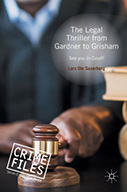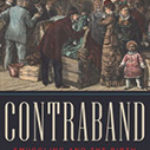The Legal Thriller From Gardner To Grisham: See You In Court!

Author: Lars Ole Sauerberg
Publisher: London: Palgrave Macmillan, 2016. 199p.
Reviewer: David Ray Papke | January 2018
Lars Ole Sauerberg’s The Legal Thriller from Gardner to Grisham: See You in Court! is a welcome volume for both fans of the legal thriller and scholars interested in crime-related popular culture. The author offers a spirited attempt to define printed legal thrillers as a genre and an insightful tour of what he characterizes as “a sufficiently representational overview” of individual legal thrillers (Sauerberg, vii). Throughout these pursuits, Sauerberg is especially adept at capturing the special role the legal thriller plays in the culture and society of the United States.
The Legal Thriller as Genre
It might seem curious that Sauerberg devotes the first two chapters of his work to the forms of crime-related popular fiction and especially to defining the printed legal thriller as a genre. Works in a genre, of course, bear a striking resemblance to one another, and the writers of generic works do not so much break new ground as they attempt to add a twist or turn within the genre. Readers frequently come to works with pronounced expectations. If a work strays too far from an established genre’s norms, purchasers of what they thought was a generic work might seek to have their money refunded!
With good reason, scholars of popular culture often pause to reflect on the make-up of genres. The emergence and popularity of a genre tells scholars something important about the hopes and fears of the people who consume the genre. A genre, as a result, is often better than an individual work as a window on a time and culture. Then, too, there is the always-difficult issue of pop cultural impact. Readers of generic printed works tend to return to their preferred genre time and again, with each individual work within the genre providing a gentle drilling in the genre’s core values, political alignment, and general worldview. Presumably, this regular reading of a particular type of popular culture has an impact on the unsuspecting consumer.
So, Sauerberg is more than justified in devoting as much attention as he does to the characterization of the legal thriller. He is determined to capture it as a specific type of crime-related fiction and to distinguish it from thrillers in general. His thinking is that in a legal thriller “the machinery of the law has pride of place in a narrative structured by suspense elements” (Sauerberg, 14).
The problem, meanwhile, is the way Sauerberg ultimately points to the courtroom trial as the defining feature of the legal thriller. In his opinion, the narrative inevitably focuses on the examination of witnesses, presentation of evidence, and general argumentation in the courtroom. To quote the author, “The courtroom and its conventions constitute the narrative bottleneck through which everything must pass” (Sauerberg, 32).
Greatly complicating Sauerberg’s argument is the tremendous variance in the magnitude, placement, and ultimate importance of courtroom proceedings in what he and others would consider legal thrillers. While sometimes, such as in the drama Inherit the Wind, the courtroom proceedings run throughout the work, in other works such as Stephen King’s Rita Hayworth and Shawshank Redemption the courtroom proceedings merely launch the work. In the nicely alliterative title of his work, the author identifies John Grisham as one of the two most important authors of legal thrillers, and Grisham is indeed often credited with being the first to identify the legal thriller as a genre. (See John Grisham, “The Rise of the Legal Thriller: Why Lawyers Are Throwing the Books at Us,” New York Times Book Review, October 8, 1992). However, trial and courtroom proceedings play very limited roles in such extremely popular legal thrillers by Grisham as The Firm, The Client, and The Pelican Brief.
For my own part, I would be inclined to see the courtroom trial as trope rather than a defining feature of a genre. In American popular fiction, at least, the courtroom setting, characters, and plot do not really correspond to the actual courtroom trial, but instead are highly standardized as popular cultural constructs. Readers find meaning in the fictional courtroom trials, and, this “meaning” usually involves much more than just the outcome of the trial. Yet the importance or potential importance of the courtroom trial trope notwithstanding, the trope does not define the genre. It appears in many works that could not be considered legal thrillers, and in legal thrillers themselves the courtroom has a myriad of roles. In fact, in some of the best legal thrillers the courtroom trial has no role whatsoever.
To Sauerberg’s credit, his discussion of the make-up of the legal thriller as a genre is animated and engaging. At the end of two chapters devoted largely to defining the legal thriller as a genre, he even seems to acknowledge the problem with his definition: “Legal thrillers differ structurally. At one end there is the regular courtroom drama, in which the essentials of the plot take place before the bench. At the other end is the kind of story hinged upon some affinity with the agents of the legal world, such as the lawyer acting as crime investigator . . .” (Sauerberg, 33-34).
Thrillers Galore
The remainder of Sauerberg’s study surveys dozens of legal thrillers, using a rudimentary historical timeline to arrange the discussion. Although several of his chapters deteriorate into annotated listings of selected novels, he shares insights regarding the works gathered at each stop on his tour.
Sauerberg begins, appropriately enough, with a chapter on the pulp fiction of the early twentieth century. He correctly identifies the prolific Erle Stanley Garner as the most important figure from the period, although it is a bit of an overstatement to say Gardner “must be credited as the writer who pioneered the American legal thriller and probably set the pattern for the genre worldwide” (Sauerberg, 46). Gardner surely illustrates Sauerberg’s observation that: “Whereas the short format favours the surprising ending, quick solution, or even twist in the tail, the longer format is ideally suited to follow the often quite detailed and prolonged negotiations in court” (Sauerberg, 25). Gardner published several short stories in the legendary Black Mask in the early 1930s before publishing no fewer than 82 Perry Mason novels.
Sauerberg next turns to the post-World War II era and provides an especially interesting chapter on British legal thrillers. The British system of adversarial or accusatorial courtroom proceedings serves as a backdrop for fictional courtroom narratives. The magisterial proceedings of civil law countries, the author argues, do not serve as well. However, the author perceives a deep-seated limitation on British legal thrillers, to wit, the “barrier between the populace at large and its courts – an aristocratic self-relying system, as it were . . .” (Sauerberg, 98).
In the three subsequent chapters, Sauerberg discusses the “American Genre Explosion from the Late ‘80s” (Sauerberg, xv) and the evolution of the genre into the twenty-first century. Lawyer protagonists have gradually become less heroic and more vulnerable to assorted existential demons, and a significant number of those protagonists are now women. Male protagonists still greatly outnumber female protagonists, but as the author points out in a chapter devoted to female writers, the number of women in legal thrillers is growing quickly. If the author wishes to expand his discussion of legal thrillers published by women he could include the novels of the American lawyer/author Lisa Scottoline. Her numerous works are immensely popular, and Scottoline herself is often referred to as “the female John Grisham” (See, e.g., Andrea Sachs, “Novelist Lisa Scottoline, Time, April 13, 2009).
Sauerberg makes the important point that crime thrillers by women are more likely to raise gender-related issues. This derives in part from the gender of the writers and of their protagonists, but the gender-related issues also come to the fore because the writers are portraying a traditionally male-dominated domain, namely, litigation. When a woman writes fiction about a woman in this domain, gender issues almost automatically surface.
Rising to the surface at several points in Sauerberg’s study is the tantalizing suggestion that the legal thriller is especially suited for portraying American life and for becoming popular in that setting. From the author’s perspective, life in the United States is a churning, contentious place with abundant class, ethnic, and racial divisions. The writers of legal thrillers (as well as residents of the United States in general) “face squarely a contemporary American reality in which borders have been debated widely and new ones are drawn or in the process of being drawn” (Sauerberg, 110). In this context, law “is part of everyday social intercourse, as it were” (Sauerberg, 98), and the “courtroom is a microcosm of society, with the conflicts treated according to traditional time-proven choreographies” (Sauerberg, 110). In the legal thrillers the courtroom becomes a place for sorting out and clarifying American values. Devoted readers of legal thrillers relish the opportunity to visit the fictional courtroom, find out who was guilty and who was innocent, and – most importantly – learn about the values of the society they call home.
—
David Ray Papke is Professor of Law at Marquette University in Milwaukee, Wisconsin, USA. He is the co-author of Law and Popular Culture: Text, Notes, and Questions (LexisNexis, 2007; second edition 2012), the first comprehensive textbook devoted to the relationship of law and popular culture.


